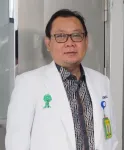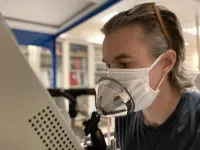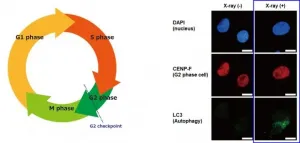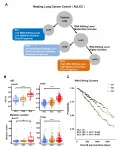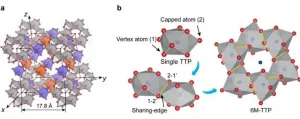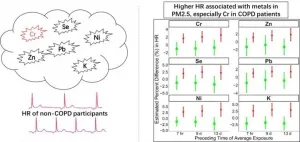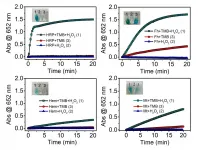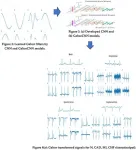(Press-News.org) Durham, NC - Critically ill COVID-19 patients treated with non-altered stem cells from umbilical cord connective tissue were more than twice as likely to survive as those who did not have the treatment, according to a study published today in STEM CELLS Translational Medicine.
The clinical trial, carried out at four hospitals in Jakarta, Indonesia, also showed that administering the treatment to COVID-19 patients with an added chronic health condition such as diabetes, hypertension or kidney disease increased their survival more than fourfold.
All 40 patients who took part in the double-blind, controlled, randomized study were adults in intensive care who had been intubated due to COVID-19-induced pneumonia. Half were given intravenous infusions containing umbilical mesenchymal stromal cells, or stem cells derived from the connective tissue of a human birth cord, and half were given infusions without them.
The survival rate of those receiving the stem cells was 2.5 times higher and climbed even more - 4.5 times - in the COVID-19 patients who had other chronic health conditions, said Ismail Hadisoebroto Dilogo, professor of medicine at Cipto Mangunkusumo Central Hospital-Universitas Indonesia and research team member.
The stem cell infusion also was found to be safe and well-tolerated with no life-threatening complications or acute allergic reactions in seven days of post-infusion monitoring, he said.
Previous clinical trials have shown that treating COVID-19 pneumonia patients with stem cells from umbilical cord connective tissue may help them survive and recover more quickly, but the Indonesian study is the first to treat intubated, critically ill COVID-19 pneumonia patients with a naive, or non-genetically manipulated, form of the stem cells.
"Unlike other studies, our trial used stem cells obtained through explants from actual umbilical cord tissue and we did not manipulate them to exclude ACE2, a cellular protein thought to be an entry point for COVID-19," Dilogo said.
Some research suggests that one of the main causes of acute respiratory distress in COVID-19 patients is "cytokine storm," a condition in which infection prompts the body's immune system to flood the bloodstream with inflammatory proteins.
"The exact cause of cytokine storm is still unknown, but our study indicates that the presence of non-manipulated umbilical cord stromal stem cells improves patient survival by modulating the immune system toward an anti-inflammatory immune state," Dilogo said.
Since there is no cure for COVID-19, supportive care has been the only help available for patients who are critically ill with the virus.
"Although our study focused on a small number of patients, we think this experimental treatment could potentially lead to an effective adjuvant therapy for COVID-19 patients in intensive care who do not respond to conventional supportive treatment," he said.
Dilogo's research team launched the clinical trial last year after the COVID-19 occupancy rate in Jakarta's intensive care units climbed to 80 percent and the mortality rate of critically ill COVID-19 pneumonia patients in the ICUs reached 87 percent.
"This study, which assessed the potential therapeutic effect of human umbilical-cord mesenchymal stem cells on critically-ill COVID-19 patients, provides promising results that could inform a potential treatment to increase survival rates," said Anthony Atala, M.D., Editor-in-Chief of STEM CELLS Translational Medicine and Director of the Wake Forest Institute for Regenerative Medicine. "Having additional potential therapies, such as MSCs, could be highly beneficial for these patients."
INFORMATION:
The full article, "Umbilical Cord Mesenchymal Stromal Cells as Critical COVID-19 Adjuvant Therapy: A Randomized Controlled Trial" can be accessed at https://stemcellsjournals.onlinelibrary.wiley.com/doi/abs/10.1002/sctm.21-0046.
About STEM CELLS Translational Medicine: STEM CELLS Translational Medicine (SCTM), co-published by AlphaMed Press and Wiley, is a monthly peer-reviewed publication dedicated to significantly advancing the clinical utilization of stem cell molecular and cellular biology. By bridging stem cell research and clinical trials, SCTM will help move applications of these critical investigations closer to accepted best practices. SCTM is the official journal partner of Regenerative Medicine Foundation.
About AlphaMed Press: Established in 1983, AlphaMed Press with offices in Durham, NC, San Francisco, CA, and Belfast, Northern Ireland, publishes two other internationally renowned peer-reviewed journals: STEM CELLS® (http://www.StemCells.com), celebrating its 39th year, is the world's first journal devoted to this fast paced field of research. The Oncologist® (http://www.TheOncologist.com), also a monthly peer-reviewed publication, entering its 26th year, is devoted to community and hospital-based oncologists and physicians entrusted with cancer patient care. All three journals are premier periodicals with globally recognized editorial boards dedicated to advancing knowledge and education in their focused disciplines.
About Wiley: Wiley, a global company, helps people and organizations develop the skills and knowledge they need to succeed. Our online scientific, technical, medical and scholarly journals, combined with our digital learning, assessment and certification solutions, help universities, learned societies, businesses, governments and individuals increase the academic and professional impact of their work. For more than 200 years, we have delivered consistent performance to our stakeholders. The company's website can be accessed at http://www.wiley.com.
About Regenerative Medicine Foundation (RMF): The non-profit Regenerative Medicine Foundation fosters strategic collaborations to accelerate the development of regenerative medicine to improve health and deliver cures. RMF pursues its mission by producing its flagship World Stem Cell Summit, honouring leaders through the Stem Cell and Regenerative Medicine Action Awards, and promoting educational initiatives.
A new study from the University of California, Davis and the Icahn School of Medicine at Mount Sinai confirms that surgical masks effectively reduce outgoing airborne particles from talking or coughing, even after allowing for leakage around the edges of the mask. The results are published June 8 in Scientific Reports.
Wearing masks and other face coverings can reduce the flow of airborne particles that are produced during breathing, talking, coughing or sneezing, protecting others from viruses carried by those particles such as SARS-CoV2 and influenza, said Christopher Cappa, professor ...
Of all the different types of cancer known, a subtype of pancreatic cancer called pancreatic ductal adenocarcinoma (PDAC) is among the most aggressive and deadly. This disease begins in the cells that make up certain small ducts in the pancreas and progresses silently, usually causing no symptoms until advanced tumors actually obstruct these ducts or spread to other places. PDAC is not only difficult to diagnose, but also very unresponsive to available treatments. In particular, researchers have noted that PDAC cells can usually survive radiotherapy through mechanisms that remain largely unknown.
Part of the Radiation and Cancer Biology ...
A new physiological measurement of heart function developed at UVA Health could improve survival for people with heart failure by identifying high-risk patients who require tailored treatments, a new study suggests.
The study is the first to show a survival benefit from wireless pressure monitoring sensors implanted in the pulmonary arteries. Pulmonary artery proportional pulse pressure, or PAPP, is a new measure of heart function, developed at UVA, that can identify patients at very high risk of hospitalization or death from systolic heart failure or pulmonary hypertension (high blood pressure in the heart and ...
Tropical cyclones (TCs) are humbling and powerful forces of nature that can have tremendous impacts on people and human populations. Meteorologists have strived to improve TC forecasting skill, hoping to save lives. In the past few decades, TC track forecasts over the western North Pacific (WNP) have progressed considerably. However, TC intensity forecasts have improved insignificantly, with only a 3-5 day lead time. Therefore, improving TC intensity forecast skill and extending lead forecast time are important and urgent issues.
To address this critical problem, a research group led by Prof. Ruifen ZHAN from the Department of Atmospheric and Ocean Sciences/Institute of Atmospheric Sciences at Fudan University, along with the Shanghai Typhoon Institute of China Meteorological ...
The incidence rate of lung adenocarcinoma (LUAD) is increasing gradually and the mortality is still high. Recent advances in the genomic profile of LUAD have identified a number of driver alterations in specific genes, enabling molecular classification and targeted therapy accordingly. However, only a fraction of LUAD patients with those driver mutations could benefit from targeted therapy, and the remaining large numbers of patients were unclassified. RNA editing events are those nucleotide changes in the RNA. Currently, the role of RNA editing events ...
Glass is one of the most common subjects we see every day, but the detailed structure of this non-metallic and non-liquid material has always been a major mystery in science. A research team co-led by scientists at City University of Hong Kong (CityU) has successfully discovered that the amorphous and crystalline metallic glass have the same structural building blocks. And it is the connectivity between these blocks that distinguishes the crystalline and amorphous states of the material. The findings shed light on the understanding of glass structure.
Glass is a non-crystalline amorphous solid which has widespread practical and technological use in daily life. Besides the soda-lime glass used in windows, there are many other ...
Epidemiological and toxicological studies indicate that the adverse outcomes of PM2.5 exposure associated closely with the chemical composition in PM2.5. Metals in PM2.5 are highly concerned for their induced disruption of iron homeostasis in the lung and following oxidative stress, which is one of the key mechanisms underlying the cardiovascular autonomic dysfunction of PM2.5 exposure. However, there is no clear evidence on whether COPD patients are more susceptible to cardiovascular autonomic dysfunction associated with exposure to metals in ambient PM2.5 than individuals without COPD. Based on a panel study, the researchers directly compared metal-associated cardiovascular autonomic dysfunction between COPD patients and healthy controls.
"We observed higher levels of heart ...
Supermassive black holes (SMBH) occupy the center of galaxies, with masses ranging from one million to 10 billion solar masses. Some SMBHs are in a bright phase called active galactic nuclei (AGN).
AGNs will eventually burn out since there is a maximum mass limit for SMBHs; scientists have long since pondered when that will be.
Tohoku University's Kohei Ichikawa and his research group may have discovered an AGN towards the end of its life span by accident after catching an AGN signal from the Arp 187 galaxy.
Through observing the radio images in the galaxy using two astronomy observatories - the Atacama Large Millimeter/submillimeter Array (ALMA) and the Very Large Array (VLA) - ...
Globally, the Earth system has thousands of terragrams (Tg) (1 Tg = 10 12 g) of mineral nanoparticles moving around the planet each year. These mineral nanoparticles are ubiquitously distributed throughout the atmosphere, oceans, waters, soils, in and/or on most living organisms, and even within proteins such as ferritin. In natural environments, mineral nanozymes can be produced by two pathways: "top down" and "bottom up" processes. Specifically, the weathering or human-promoted breakdown of bulk materials can result in nanomaterials directly (a top-down process), or nanomaterials ...
A team of researchers from Nanyang Technological University, Singapore (NTU Singapore), Ngee Ann Polytechnic, Singapore (NP), and the National Heart Centre Singapore (NHCS) have invented a tool that could speed up the diagnosis of cardiovascular diseases.
Powered by artificial intelligence (AI), their innovation uses electrocardiograms (ECGs) to diagnose coronary artery disease, myocardial infarction and congestive heart failure to an accuracy of more than 98.5 per cent.
The joint development of the diagnostic tool is timely, as the number of deaths caused by cardiovascular disease in Singapore has increased over the past three years. According to the Singapore Heart Foundation, 29.3 per cent of all deaths in Singapore in 2019, or almost 1 out of 3 deaths in Singapore, was due to heart ...
